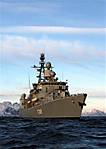I had such a good time recently with Pyro’s ancient Niña kit that before it was even finished I went and found a Pinta and a Santa María to go along with it!

I thought I‘d start with the Pinta, the ship of Columbus’ famous fleet about which we know the least. Like the Niña, the Pinta was a small carabela redonda (caravel). She was square rigged, probably about 73-75 feet in length, and had a crew of 26 (compared to Niña’s 24 and Santa María’s 40). The only historical records concerning the ship have to do with Columbus’ voyage of discovery in 1492. What we do know is that the Pinta was owned by Cristóbal Quintero of Palos, and that she was commandeered by Queen Ysabel (Isabella) of Castile for Columbus’ voyage. The ship was captained by Martín Alonso Pinzón, an experienced mariner ten years Columbus’ senior. Columbus mentions in his log that shortly after leaving Spain the Pinta had rudder trouble, but he was confident that Pinzón, “a man of energy and ingenuity”, could resolve the problem - which he did. Pinta’s captain was also reputedly instrumental in helping Columbus calm the mutinous crew of the Santa María during the outward passage. Unfortunately, Pinzón’s energy and ingenuity were not matched with discipline; throughout the voyage he had a habit of sailing off ahead and losing contact with the rest of the fleet. On October 12, 1492, this resulted in Pinta’s seaman Rodrigo de Triana being the first European since the Vikings to set eyes on the New World (although Columbus later cheated the man of his reward, claiming to have seen land himself the night before!) Later, as the fleet explored the Caribbean islands, Pinta again disappeared (apparently hunting for gold) for nearly four months before rejoining Columbus. No gold was found, but Pinta had earned the distinction of being the first European ship to reach Haiti. Finally, as the ships were headed home, Captain Pinzón’s Pinta again abandoned Columbus midocean and became the first ship to reach Europe with news of the Discovery.
After that… nothing. There was the so-called “Molasses Reef wreck” found in Turks & Caicos Islands near Cuba in 1976 which was thought by some to have been the Pinta, but although of the correct size and age, no evidence for any specific identification of the wreck has ever been found. As far as history is concerned, the story of the Pinta ends with her arrival home at Palos, Spain in 1493.
















































